South Pacific Cruising in 2021
Behan Gifford and family chose not to cross the Pacific last year and remained in Mexico. Frustrated by the number of cruising boats planning on “cruising” the Pacific this year, she has published the current situation on her blog. This is an informative summary of what to expect if you are thinking about crossing the great Pacific in 2021.
Published 4 years ago
Another day, another boat talking about heading to the South Pacific this year.
What are they thinking?
That’s my first reaction, anyway. To be clear, there are some scenarios that make sense. I’ll get to that: more generally, it does not make sense for most boats at this time. But it seems that the advent of vaccine availability, and perhaps unbridled or uninformed hope, has prompted many plans to head that way regardless.
Stepping back: right now, there are exactly two countries conditionally open to foreign yacht arrivals in the South Pacific. Both require advance permission, which is not assured. Let’s review.
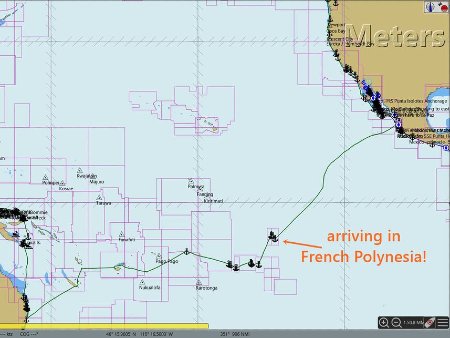

First: some context. The Pacific Ocean is ^%#*ing HUGE.
When people get to French Polynesia and crow “we’ve crossed the Pacific!” – no. They are about one third of the way. There’s a lot of ocean not yet “crossed.” Ballpark, in very round numbers: it’s about 9,000 nautical miles across, and Panama (or Mexico) to the Marquesas is about 3,000 nautical miles.
Second: let’s look at those two countries that offer the possibility of arrival:
French Polynesia and Fiji.
French Polynesia’s maritime borders remain officially closed.
Permission to enter is by application to DPAM (a department for maritime affairs; not related to the consulate). Many have been allowed, but plenty boats from a range of flags have been declined.
It does seem that local yacht agents may have better luck with the process. We had a great experience with an agent in 2010, and had contacted Tahiti Crew for services last year before covid blew up. Kevin Ellis at Yacht Services Nuku-Hiva has assisted others.
For crews who obtain permission to arrive in French Polynesia, the duration of stay allowed is based on nationality. 90-day visas are granted; French Polynesia stopped issuing Long-Stay Visas (LSVs) last year. EU nationals are able to stay longer. In our experience those 90 days will fly by, although that’s not unreasonable for a boat planning to get all the way across to Australia in one non-cyclone season.

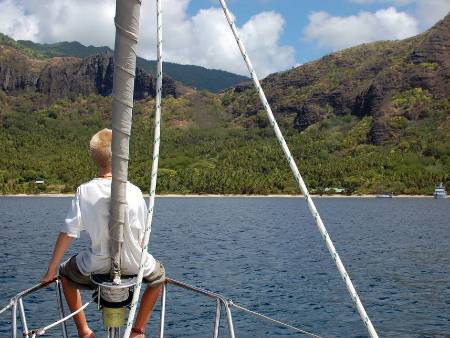
- Niall spots Totem’s path into a Marquesan anchorage; 2010
Fiji’s Blue Lane initiative has, like French Polynesia, provided for conditional access to cruising boats.
You must apply and have approval before embarking for Fiji. Application is made through one of few approved yacht agents. Crews must provide an advance Covid test (and another after arrival) and meet other requirements such as insurance, visa, and biosecurity. At least sea time is counted towards the 14-day quarantine!
It adds up: for our crew, I priced the cost to enter at $2,140 (not including the additional required marina stay).
SO we’ve got French Poly, and Fiji. That means some big @$$ passages. It skips Tonga and the Cook islands, Samoa and Niue too, on the way to Fiji; it means no stopping at Vanuatu and New Caledonia when carrying westward. All shuttered for arrivals. And then… where do you go from there? This leads us to…
Third: hurricane season options
Since the pace of vaccine distribution suggests that 2021 will not reach levels allowing other countries in the Pacific to open their borders 2021, destinations for hurricane season are limited. But let’s focus on typical off-season cruising destinations for the South Pacific: Australia and New Zealand. Both offer distant possibilities, neither can be counted on unless you are a repatriating national. For the non-nationals:
- Hope that Australia provides ‘emergency’ access again.
After the scare of a big cyclone tearing through Fiji this season, some boats did go on to Australia – opened only thanks to massive effort from outstanding members of the cruising community (the Down Under Rally’s Hembrows, John and Lyn Martin of Sail South Pacific, and Guy Chester – Ocean Cruising Club member/cruiser at large). They were required to quarantine in a hotel room selected (and serviced: here’s breakfast!) by the government, at the yachties’ expense, while the boat is (also at their expense) in a marina. Expensive. - Pony up for a New Zealand refit.
Commit to spending $50,000 NZD (about US$35,000) in New Zealand on vessel refitting and maintenance work, and you can apply for entry. It is not a guaranteed pay-to-arrive, boats have been turned down; but it is one gating factor that opens it as a possibility for non-NZ crews. Damn, this is actually near the level of our annual budget!
Why are people going?
I mentioned at the beginning that there are a few circumstances where it makes sense to set off. Below are the scenarios, but the crews I read about looking to cross … mostly don’t fit into the criteria for following through on them. Basically: the options aren’t horror shows, but they are either quite expensive (fine if you’ve got it), quite inconvenient, or quite significant passages.
1. Exit and return to French Polynesia.
Leave the boat at a marina French Polynesia and fly out. After 90 days outside the country, your visa clock is reset and you are granted another 90 days. This may be a hardship for many ‘typical’ cruisers who don’t have a land base waiting for them, but it is an option.
2. Route to Hawaii (if immigration status permits)
From there, back to the North American mainland – or back south to French Polynesia again after spending the requisite 90 days outside of the country. Must have immigration status that allows entry to the USA and love long passages. And once you’re in Hawaii, anchoring permits cost more than a marina in Mexico and marina waiting lists are real. So not many choose this path because, well, it’s harder.

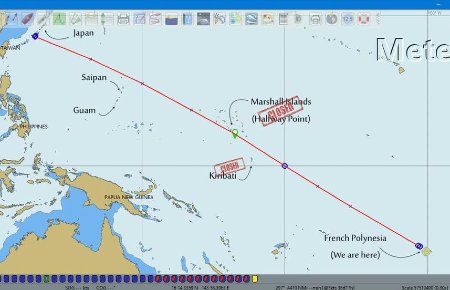
- Cool bonus option: sail the 5,400 miles from French Poly to Japan! Credit: SV Maple
3. Make a North Pacific loop to Japan.
Friends on the Leopard 384, Maple, have made plans to sail from French Polynesia to Japan (then, onward home to Canada), which frankly sounds pretty sweet although it may be thwarted by a leaky fuel tank. We’re rooting for them!
[see Japan update in comments below]
4. Nationals repatriating.
This is the option available to Aussies and Kiwis – who are still subject to quarantine.
The South Pacific is CLOSED
Since the rest of the South Pacific (and most of the North Pacific) is closed, and offers NO indication of opening anytime soon (regardless of protocol, regardless of vaccines – in fact, Vanuatu and New Caledonia just doubled down to be 100% clear on their we’re-not-open status), it is baffling to me that there’s so much murmuring about plans for the Pacific.

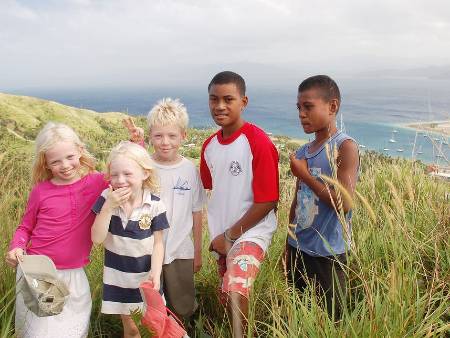
- 2010: will never forget these friendly Fijian boys who showed us a trail to the ridgetop
I suppose that’s a little like wondering why back in our home country so many activities are opening up despite transmission risks being pretty much worse than ever. Pandemic fatigue is real!
If one were to believe that vaccination distribution will occur widely and quickly (despite all evidence to the contrary), it might be possible to have hope for South Pacific cruising. But it’s not happening quickly, and vulnerable countries have no more incentive to take the risk now than they did in 2020. I really don’t know what most people making plans are thinking.
Here on Totem, we just keep on keepin’ on. You bet we want to be back to the south Pacific, and into the north Pacific, but… oh well!
Behan Gifford
SY Totem
See full article at https://www.sailingtotem.com/blog/south-pacific-cruising-in-2021
This article was also published in Cruising World https://www.cruisingworld.com/story/destinations/sailing-totem-south-pacific-cruising-in-2021/
………………………………………………………………………………………………………………………………………
As a footnote, Guy Chester, who was instrumental in getting borders opened for yachts transiting the Pacific in 2020, gives his thoughts.
PACIFIC CROSSING IN 2021?
As an Aussie who did leave Panama and cross the Pacific in 2020 I have to date refrained from commenting re anyone crossing in 2021. However after the advocacy work I and others undertook on behalf of the OCC its important to understand the situation.
Things change quickly and this year isn’t going to suddenly have open borders. My take away is that Aussies and Kiwis crossing must be prepared to sail straight to their home country if necessary. All other nationalities need to fully understand the border entry rules and visa rules in their intended stops (which at this stage are only French Polynesia and Fiji) and you must be prepared to stay over a cyclone season and/or leave your boat if your visa runs out.
Many 2020 crews remain in French Polynesia and are enjoying great cruising, those in Fiji right now are about to face their 3rd cyclone for the season.
We (OCC and key partners) remain working on the NZ and Australian situation but hope is limited for 2021, indeed this week a yacht in Fiji has been refused the Oz cyclone refuge exemption (for reasons we cannot establish).
………………………………………………………………………………………………………………………………………
Useful Links:
- French Polynesia Yachting Protocols
- Fiji Yachting Protocols
- Covid-19 Worldwide: Open/Closed Countries
- Noonsite Covid-19 page
Related Reports:
- Retreat from Paradise
- The tumultuous times of the COVID pandemic (Guy Chester – Dec, 2020)
- Routing – Pacific Ocean South
…………………………………………………………………………………………………………………………………..
The opinions expressed in this article are the author’s own and do not reflect the view of Noonsite.com or World Cruising Club.
Related to following destinations: Cook Islands, Fiji, French Polynesia, Galapagos, New Caledonia, Niue, Panama, Samoa, Solomon Islands, Tonga, Vanuatu
Related to the following Cruising Resources: COVID-19, Cruising Information, Pacific Ocean South, Planning and Preparation, Routing




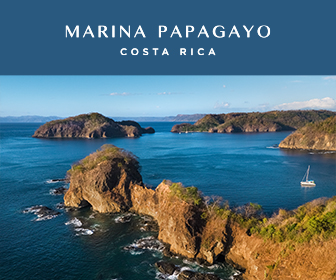
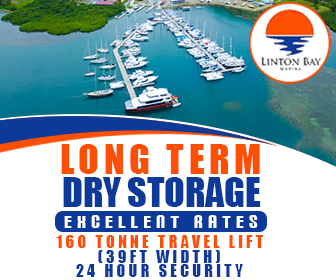


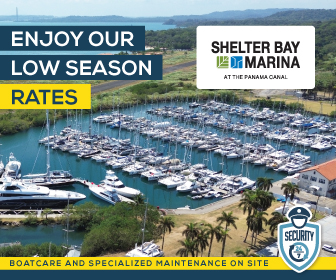

Japan: Covid-19 Update (February 2nd, 2021)
By Kirk Patterson – Konpira Consulting [https://www.konpira-consulting.com/]
Like all other countries, Japan has struggled to cope with the Covid-19 pandemic, but it has done better than most and so daily life, especially where I live in Fukuoka, has gone on almost as normal. The virus has, of course, made international travel difficult.
For cruisers, there are two Covid-19—related barriers to clear.
Entering the country:
One is prohibited from entering Japan if one has been in any country on the “banned list” (which is virtually all countries) within the previous 14 days. Spending over 14 days at sea, though, means that one can enter Japan.
Getting a visa:
Japan has suspended the visa-exemption agreements for virtually all countries, so most people who want to visit Japan have to apply for a visa in advance, and all tourist visa requests are being rejected. However, the visa-exemption agreements with the United States and Canada are still in effect, so citizens of those countries can receive a 90-day visa upon arrival. (The visa-exemption agreements with Australia, New Zealand, and Taiwan had been in effect, but they were recently suspended.)
My guess is that Japan will not significantly open up to visitors in 2021. The only thing that is keeping Japan even slightly open is the hope that the Tokyo Olympics can be held this summer. If the Olympics are postponed or cancelled, Japan may institute a very strict ban on foreign visitors, similar to what New Zealand has done.